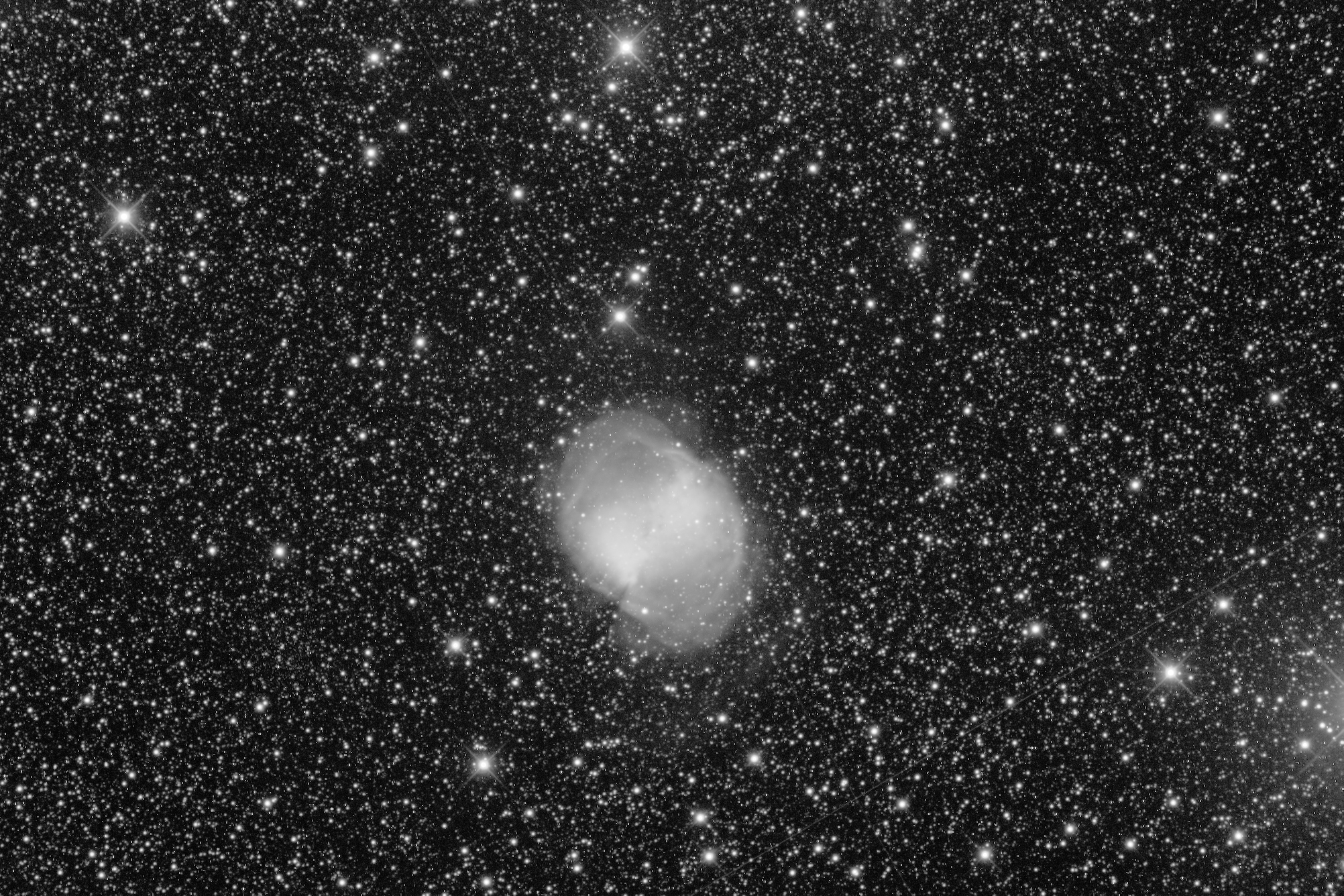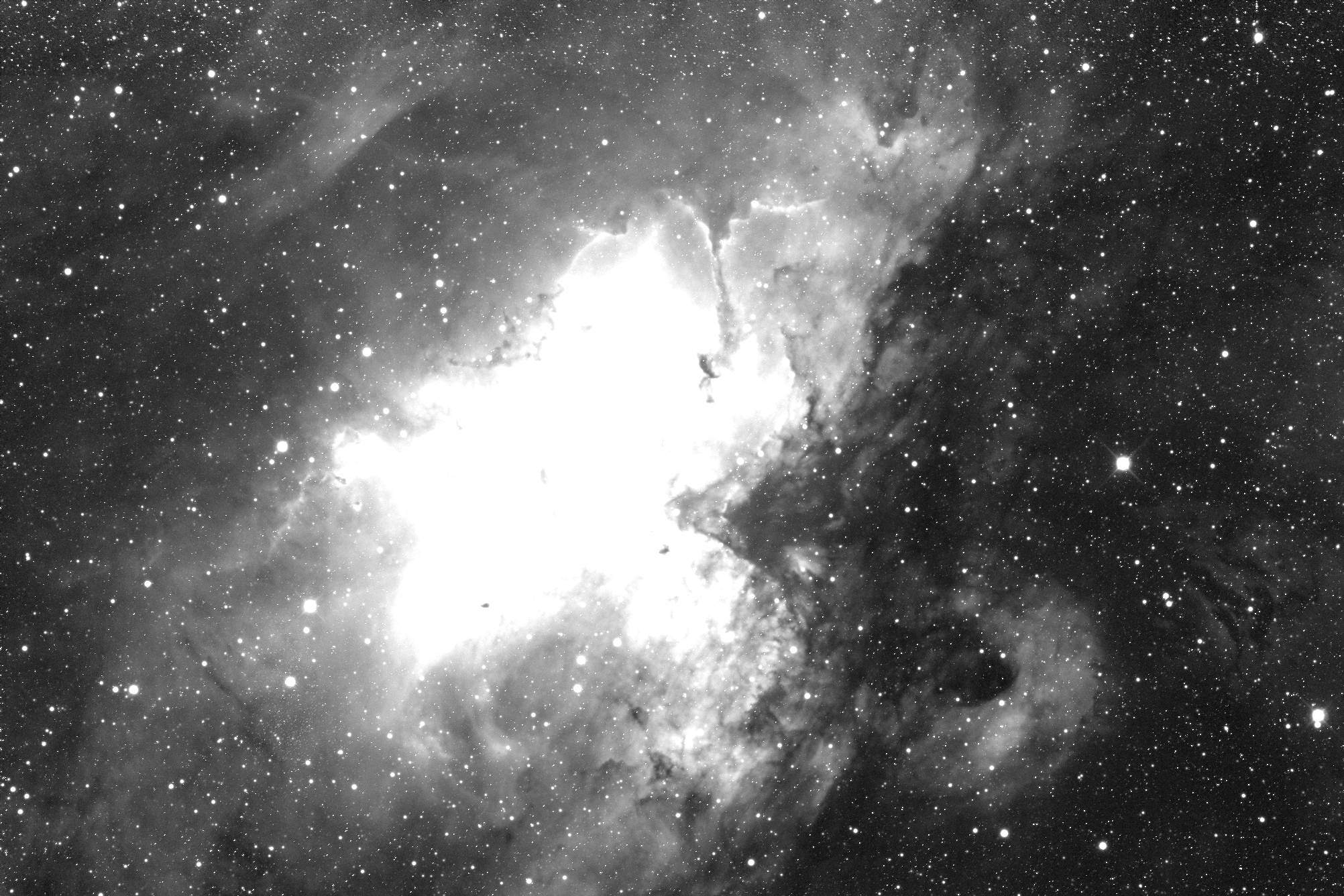Last week I captured 12x 300s luminance frames of the interior of M31, centered on the variable star M31 V0619. I did get some good photometry out of the two best frames, but yesterday I thought that I might want to make an actual image out of all of the data.
I used tools that I was familiar with: AstroImageJ for calibration, alignment, and stacking, and StarTools for post-processing. (I have used APP but my license expired since I don't do that much AP now.)
My image came out very nicely except for dust donuts along the periphery of the image. I handed the data off to my friend who is an APP wizard. I've attached his image, minus denoising so you can clearly see the donuts.
We had a look at the 6 flat files provided at the Calibration link. These appear to be Sky Flats. The first two files used a 1-second exposure and the remaining four used a 2-second exposure. The mean of the histogram was well-below 32,000 ADU with the 1-second frames and around 49,000 ADU in the 2-second frames, but there was a lot of variability due to the sky brightness, I would assume.
The 2-second Flats showed many more donuts along the edges of the frame. That's a good thing in my estimation. The one thing that is most pronounced is the high degree of vignetting which would be expected with a 36x24mm sensor.
When I image here at home I take 30x flats. Could the problem I see with dust donuts be a combination of:
a. Too few flats.
b. Exposure too short.
Thanks,
Brian
PS: Also, I've noticed "banding" in Pier 12 images, even those published by others here. I find this very odd since banding is usually a problem with CMOS cameras.
If you have the time take a look at Mike's image from Pier 12:
https://www.roboscopes.com/index.php/forum/latest/242-vdb152-pier12
Zoom in on the brownish nebula. Do you see the vertical bands?
I've stretched the heck out of my individual lights, calibrated and uncalibrated. I can not see bands but they are definitely there in the stack so it must be very subtle in each frame. BTW, the bands show regardless of the tool used: APP or AstroImageJ. I'm guessing that Mike used PI so the bands are real.
Thanks,
Brian
APP 1.082 – used all defaults ‘out of the box’ for calibration/integration. DPP was 15, 3, 2.5%, sharpen, stretch,
contrast. Neat Image 8 for denoise (used all defaults).
Brian
Brian
I do a lot of Photometry. One of my goals is to capture the light curve of the Cepheid variable star M31 V0619. That's the variable star that Edwin Hubble discovered in 1923 that helped determine the distance to the galaxy. Up until that time it was believed that M31 was just a nebula within the Milky Way. If you measure the period of a Cepheid type variable you can then run it through Leavitt's Law to determine its distance. Henrietta Leavitt was a colleague of Edwin Hubble.
The exact coordinates I got from here:
https://www.aavso.org/vsx/index.php?view=detail.top&oid=241535
Here is the star field with precise measurements of comparison stars:
https://www.aavso.org/apps/vsp/chart/?east=right&fov=30.0&scale=E&star=M31+V0619&orientation=visual&maglimit=16.5&resolution=150&P=on&north=down&Z=on&type=chart
https://www.aavso.org/apps/vsp/photometry/?east=right&fov=30.0&scale=E&star=M31+V0619&orientation=visual&maglimit=16.5&resolution=150&P=on&north=down&Z=on&type=chart
Brian
The KAI11002 Chip is prone to the "venetian Blind" effect in earlier versions of Photoshop there was a correction tool for the anomoly. in fact starlight Xpress even added one to thier drive for the H35 camera.
I think Pete is looking how to do it in modern Photoshop and Pixinsite at the moement
Please ignore my dylexia wherever possible, just be thankful I can control my Tourettes ;)
Things to do, so little time!
Steve
Roboscopes Tea Boy
Dave
This is not about donuts, really fancy one right now though, but what has been referred to as a venetian blind effect seen on some images. The attached is an image crop from a total integration time of 5 1/2 hours with an O3 filter from this pier, and it is just as bad on 9 hours with an S2 filter. With a much higher S/N ratio it is much less evident in the Ha filter image, but can still be made out in areas where there is less signal.
Any software solutions guys. In a previous image of M16 I was pretty well forced to use high noise reduction, which I guess I should have left until last, since I needed to use a bit more later on. This then made it difficult for me to retain detail without then needing to do some selective sharpening . All tips welcome and thanks for anything suggested.
I am somewhat surprised though that increasing the integration time is having very little effect on this issue in low S/N areas, and would have thought that dithering would have almost removed it after a reasonable number of subs. Is there any chance that the dithering algorithm in use has not been set up to move sufficiently between frames? I know this is unlikely, but from the evidence I see, that is all I can conclude.
Cheers,
Ray
Ray
Roboscopes Guinea Pig
The banding issue is down to how the data from this particular sensor is calibrated.
The most important thing is to calibrate your flats with the bias frame when creating a master flat, this is key to eliminating banding on this sensor.
I have calibrated and stacked the green channel from the M27 data set as an example and done an extreme stretch all the way to the noise floor and there is no sign of banding. Please ignore the hot pixels as I didn't run a cosmetic correction for this example.

I hope this helps.
regards
Peter
Visit my personal imaging website at astropix.co.uk
For Image Processing Tutorials
Contact: pete@ccdimaging.co.uk

We can supply your new high quality Newtonian or Dall Kirkham Astrograph
Peter Shah
Roboscopes Observatory Controller
Thanks for the interest in this. I think this would be a great idea.
I used the Pixinsight batch preprocessor to calibrate all the stacks, loading the individual frames for bias, darks and flats, so assume that the calibration was carried out correctly. Maybe APP would give a better result.
The attachment by Peter showing the green filter stack of M27 is unfortunately not the best example to use. Regarding the signal strengths I imagine that blue or green would have the strongest followed by red, then oxygen trailed by hydrogen and sulphur. The image attached does in fact still show faint traces and in one area is partially masked by hot pixels breaking up the pattern to some extent. It would therefore need to be either the O3 or S2, possibly Ha, as the banding is only really evident in those filters due to the low S/N.
Unfortunately I am not in any position to make the subs available to you as this is not data I ordered, but perhaps Steve might arrange for the O3 subs for M27 to be sent to you. Maybe alternative stacking software may cure or partially cure it. As this object will be very rich in O3 I would only expect the banding to be evident in the surrounding areas. If there is also some software within APP that would clean it up in post processing, then so much the better.
Thanks Dave,
Ray
Ray
Roboscopes Guinea Pig
Thanks for all the useful information. Really I'm seeking a solution to suppress the banding in the images I have, but my very limited skills dealing with noise means I end up applying high levels of noise reduction in Photoshop. Not the best option I'm sure. Are there alternative apps you can recommend?
Thanks, Ray
Ray
Roboscopes Guinea Pig
we are on the last batch of cal files and are now 16 hours into the 1200 and 1800second darks ?
I think its taken in excess of 2 solid days so far just in darks seeing as we now have 30 of each
Steve
Please ignore my dylexia wherever possible, just be thankful I can control my Tourettes ;)
Things to do, so little time!
Steve
Roboscopes Tea Boy
I have chosen a set of Halpha narrow band frames as this would show more so than a wider band filter. Here is a full frame of M16 in Ha pushed more than you would need to. There is no sign of banding.
If you do a calibration with the pier 12 flats you will see banding. So you must first calibrate your flats using the bias frames provided before calibrating your lights. Only then will the light frames become banding free.

Kind regards
Peter
Visit my personal imaging website at astropix.co.uk
For Image Processing Tutorials
Contact: pete@ccdimaging.co.uk

We can supply your new high quality Newtonian or Dall Kirkham Astrograph
Peter Shah
Roboscopes Observatory Controller
- Page :
- 1
- 2
Be one of the first to reply to this post!
This website uses cookies to manage authentication, navigation, and other functions. By using our website, you agree that we can place these types of cookies on your device.
You have declined cookies. This decision can be reversed.
Proud to use
-
FLI
-
656 Imaging
-
10 Micron
-
Planewave
-
ZWO
Resources
Company Details:
Roboscopes
802 Kingsbury Road
Birmingham
B24 9PS
United Kingdom





